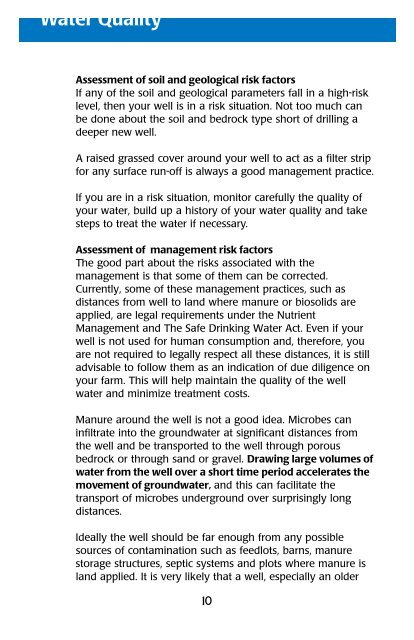Water Used To Wash Milk Contact Surfaces - Dairy Farmers of Ontario
Water Used To Wash Milk Contact Surfaces - Dairy Farmers of Ontario
Water Used To Wash Milk Contact Surfaces - Dairy Farmers of Ontario
You also want an ePaper? Increase the reach of your titles
YUMPU automatically turns print PDFs into web optimized ePapers that Google loves.
<strong>Water</strong> Quality<br />
Assessment <strong>of</strong> soil and geological risk factors<br />
If any <strong>of</strong> the soil and geological parameters fall in a high-risk<br />
level, then your well is in a risk situation. Not too much can<br />
be done about the soil and bedrock type short <strong>of</strong> drilling a<br />
deeper new well.<br />
A raised grassed cover around your well to act as a filter strip<br />
for any surface run-<strong>of</strong>f is always a good management practice.<br />
If you are in a risk situation, monitor carefully the quality <strong>of</strong><br />
your water, build up a history <strong>of</strong> your water quality and take<br />
steps to treat the water if necessary.<br />
Assessment <strong>of</strong> management risk factors<br />
The good part about the risks associated with the<br />
management is that some <strong>of</strong> them can be corrected.<br />
Currently, some <strong>of</strong> these management practices, such as<br />
distances from well to land where manure or biosolids are<br />
applied, are legal requirements under the Nutrient<br />
Management and The Safe Drinking <strong>Water</strong> Act. Even if your<br />
well is not used for human consumption and, therefore, you<br />
are not required to legally respect all these distances, it is still<br />
advisable to follow them as an indication <strong>of</strong> due diligence on<br />
your farm. This will help maintain the quality <strong>of</strong> the well<br />
water and minimize treatment costs.<br />
Manure around the well is not a good idea. Microbes can<br />
infiltrate into the groundwater at significant distances from<br />
the well and be transported to the well through porous<br />
bedrock or through sand or gravel. Drawing large volumes <strong>of</strong><br />
water from the well over a short time period accelerates the<br />
movement <strong>of</strong> groundwater, and this can facilitate the<br />
transport <strong>of</strong> microbes underground over surprisingly long<br />
distances.<br />
Ideally the well should be far enough from any possible<br />
sources <strong>of</strong> contamination such as feedlots, barns, manure<br />
storage structures, septic systems and plots where manure is<br />
land applied. It is very likely that a well, especially an older<br />
10
















